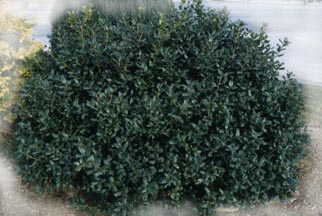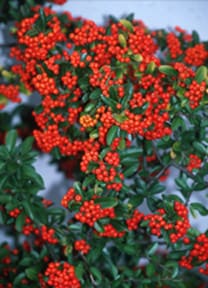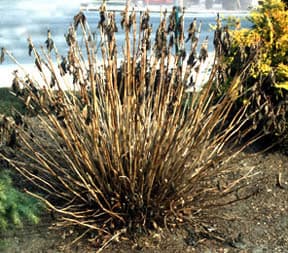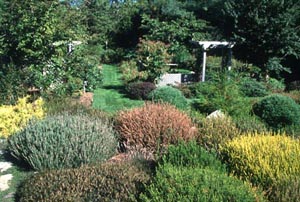Some general guidelines for the kindest cut

Japanese holly, (like yews, privet and boxwood) takes shearing well, but this does not mean that they have to be sheared!
The pruning of shrubs is somewhat like the programming of a VCR machine: both cause normally intelligent people to feel completely flummoxed. Unfortunately I can’t help you with the VCR… you’ll just have to live with that flashing clock. I can, however, list some general guidelines that will help as you contemplate your growing landscape.
Pruning vs. Shearing
Don’t confuse pruning with shearing. Shearing is clipping all the growing tips off of a shrub with a hand or electric shears, which usually results in a green globe or cube. Shearing is appropriate for hedges, topiary, and some evergreen shrubs in a formal garden, but for other plants it destroys the natural shape of the shrub and can diminish flowering. Unless you have hedges, walk by the shearing tools at your garden center, and invest in a good pair of by-pass pruners instead.
Keeping it small?
Whenever possible, prune to improve appearance, not to control size. If a shrub is getting too large for its location, have it moved. It is difficult to keep a plant both well-shaped and small. In fact, pruning stimulates growth, so the plant you trim down in order to keep it “under control”, will usually replace what you have removed within a season. Keep in mind that the plant is genetically programmed to be a certain size, and unless you’ve planted it in a bonsai dish, trying to keep it small is a losing battle.

Major pruning of pyracantha should be done right after bloom, although this will result in fewer of the showy berries the following fall. First step Remove all deadwood first. No matter which plant you are pruning, this is always the first step. You can remove deadwood anytime you can clearly identify what is living and what is dead. Sometimes this is all that is required to improve the appearance of a plant… shrubs and trees don’t need to be pruned. Second cut Next, remove crossed or rubbing branches, weak, broken or diseased growth. If there are excess suckers (young, straight shoots that have grown as a result of an over-enthusiastic pruning the
First step
Remove all deadwood first. No matter which plant you are pruning, this is always the first step. You can remove deadwood anytime you can clearly identify what is living and what is dead. Sometimes this is all that is required to improve the appearance of a plant… shrubs and trees don’t need to be pruned.
Second cut
Next, remove crossed or rubbing branches, weak, broken or diseased growth. If there are excess suckers (young, straight shoots that have grown as a result of an over-enthusiastic pruning the previous season, or around such shrubs as lilacs) remove up to 2/3 of this growth.
Prune according to bloom
In general, prune spring-flowering shrubs immediately after they stop blooming, and summer-flowering shrubs in early spring. The exceptions to this rule are the blue and pink flowering hydrangeas, and some roses that bloom on second-year growth.

Mop-head hydrangeas form their flower buds as the current flowers are fading, so no matter when you prune it’s best not to cut them way down. The shorter you cut the canes, the fewer flowers you will have the next summer! White-flowering Pee-Gee hydrangeas bloom on new growth, however, and can be cut hard in the spring if desired.
Prune by type of growth
Renew cane-growing type shrubs by cutting a third of the old stems right to the ground. This is the way to prune blue/pink Hydrangeas, Bamboo, Forsythia, Deutzia, Kerria, Mock Orange, Red-twig Dogwood, Leucothoe and Weigela.
Prune mound-growing types by simply removing any growth that does not contribute to an attractive mound shape. Grab the stem that needs to be cut back, and follow it into the shrub to where a lateral branch grows off of the main stem you are following. To keep an attractive shape, cut just above a branch that is growing away from the center of the plant. Examples of mound-growing shrubs include Abelia, Barberry, Spirea, Potentilla, Burning Bush, and Evergreen Euonymous.
Shrubs that have one trunk (or only a few stems) coming out of the ground require the least amount of pruning. Clean them up as described above, but for the best shape, do not shear or cut back from the top. Such plants include Andromeda, Rhododendron, Laurel, Viburnums, Witch hazel, and Cotoneaster. You say the Rhodys and Pieris are blocking the picture window? Move them, or trim off the lower branches to expose the trunks, so that they become small trees and the canopy can grow above the windows.

Prune winter-flowering heaths right after they finish blooming. Prune summer flowering heathers in the early spring. Heaths and heathers can be cut with pruners or sheared, but try to keep a natural, asymmetrical shape
Prune prudently
No Marine Corps haircuts! In general, remember that over pruning stimulates growth. Stop when the plant looks neater and cleaner but before it looks “pruned.”
There are always exceptions
Some specifics and exceptions: Use your pruners to cut Butterfly bush and Caryopteris down to 12″ – 20″. Heaths, heather and some of the dwarf summer-flowering spireas can be hand-sheared with a scissors right after they bloom or in early spring. You can take about a third to a half off the stems at this time. Prune hardy sage and lavender in early spring, but do not cut below live growth… taking off a third of the plant is usually safe. Cut thyme to the ground in early spring.